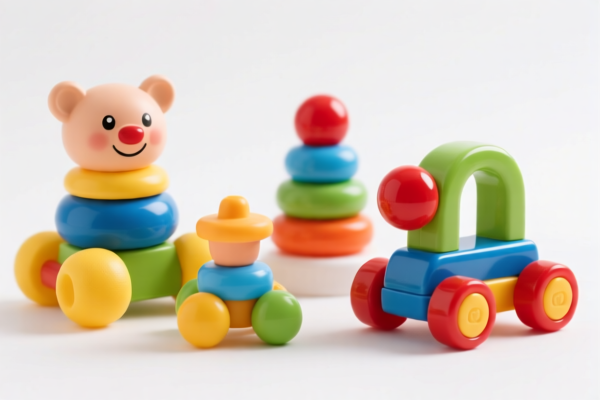| HS Code | Official Doc | Tariff Rate | Origin | Destination | Effective Date |
|---|---|---|---|---|---|
| 9503000071 | Doc | 30.0% | CN | US | 2025-05-12 |
| 9503000073 | Doc | 30.0% | CN | US | 2025-05-12 |
| 9504500000 | Doc | 30.0% | CN | US | 2025-05-12 |
| 8509805095 | Doc | 34.2% | CN | US | 2025-05-12 |
| 8509905500 | Doc | 59.2% | CN | US | 2025-05-12 |
| 3923900080 | Doc | 58.0% | CN | US | 2025-05-12 |




Electric Toys
Electric toys are playthings powered by electricity, typically using batteries, AC power, or rechargeable power sources. They encompass a broad range of items designed for entertainment and, increasingly, educational purposes.
Materials
Construction varies significantly based on the toy’s complexity and purpose. Common materials include:
- Plastics: Predominantly used for casings, bodies, and structural components due to their moldability, durability, and low cost. Types include ABS, polypropylene, and polystyrene.
- Metals: Employed for gears, axles, electrical contacts, and structural reinforcement. Common metals include steel, aluminum, and brass.
- Electronics: Crucial components include microchips, circuit boards, motors, LEDs, sensors, and speakers.
- Rubber/Silicone: Used for tires, grips, and flexible components.
- Fabrics/Textiles: Found in plush electric toys or as decorative elements.
Purpose & Function
The primary purpose of electric toys is recreation and entertainment. However, many modern electric toys also serve educational functions, promoting:
- Cognitive Development: Toys involving problem-solving, logic, and strategy.
- Motor Skills: Remote-controlled vehicles, building sets, and interactive robots.
- Creativity & Imagination: Electric art sets, programmable toys, and role-playing items.
- STEM Learning: Robotics kits, electronic building blocks, and coding toys.
Electric toys function through the use of electrical energy to create movement, sound, light, or interactive responses. This is achieved through various mechanisms, including:
- Motors: Convert electrical energy into mechanical energy, driving wheels, propellers, or other moving parts.
- Circuitry: Controls the flow of electricity, enabling specific functions and interactions.
- Sensors: Detect input from the environment (e.g., light, sound, touch) and trigger corresponding responses.
- Microcontrollers: Process information and control the toy’s behavior.
Usage Scenarios
Electric toys are used in a wide variety of settings:
- Indoor Play: Remote-controlled cars, electronic games, plush interactive toys, and building sets.
- Outdoor Play: Remote-controlled vehicles (cars, boats, airplanes), electric scooters, and ride-on toys.
- Educational Settings: Robotics kits, coding toys, and STEM-focused building sets.
- Collecting: Certain electric toys, particularly vintage or limited-edition items, are popular collectibles.
Common Types
- Remote-Controlled (RC) Vehicles: Cars, trucks, boats, airplanes, helicopters, and drones controlled wirelessly.
- Electronic Games: Handheld consoles, interactive gaming systems, and tabletop electronic games.
- Robots: Programmable robots, interactive robots, and educational robots.
- Plush Interactive Toys: Stuffed animals with electronic features such as sound, movement, and voice recognition.
- Building Sets: Electronic building blocks, construction sets with motorized components.
- Ride-on Toys: Electric scooters, electric bikes, and motorized ride-on vehicles.
- Educational Toys: STEM kits, coding toys, and robotics platforms.
- Musical Toys: Electronic keyboards, drum sets, and other instruments.
- Dolls & Action Figures: Dolls with electronic features, action figures with sound and light effects.
Electric toys are not explicitly defined as a single category within the provided reference material. However, several HS codes may be relevant depending on the specific nature of the electric toy. Here's a breakdown of potentially applicable codes:
- 9503000071: This code covers Tricycles, scooters, pedal cars and similar wheeled toys; dollsʼ carriages; dolls, other toys; reduced-scale (“scaleˮ) models and similar recreational models, working or not; puzzles of all kinds; parts and accessories thereof. Specifically, it applies to “Childrenʼs productsˮ as defined in 15 U.S.C. § 2052: Other: Labeled or determined by importer as intended for use by persons: Under 3 years of age. If the electric toy is designed for children under 3, this code is applicable. The total tax rate is 30.0%.
- 9503000073: This code also covers Tricycles, scooters, pedal cars and similar wheeled toys; dollsʼ carriages; dolls, other toys; reduced-scale (“scaleˮ) models and similar recreational models, working or not; puzzles of all kinds; parts and accessories thereof. It applies to “Childrenʼs productsˮ as defined in 15 U.S.C. § 2052: Other: Labeled or determined by importer as intended for use by persons: 3 to 12 years of age. If the electric toy is designed for children between 3 and 12, this code is applicable. The total tax rate is 30.0%.
- 8509805095: This code covers Electromechanical domestic appliances, with self-contained electric motor, other than vacuum cleaners of heading 8508; parts thereof: Other appliances: Other Other. If the electric toy functions as a domestic appliance with a self-contained electric motor, this code may be relevant. The total tax rate is 34.2%.
- 8509905500: This code covers Electromechanical domestic appliances, with self-contained electric motor, other than vacuum cleaners of heading 8508; parts thereof: Parts: Other: Other. If the electric toy consists of parts for an electromechanical domestic appliance with a self-contained electric motor, this code may be applicable. The total tax rate is 59.2%.
Important Considerations:
Regarding HS codes 9503000071 and 9503000073, it is crucial to accurately determine the intended age group for the electric toy, as this directly impacts the correct HS code selection.
Regarding HS codes 8509805095 and 8509905500, if the electric toy is classified under these codes, please note that a basic customs duty of 4.2% applies.
Customer Reviews
No reviews yet.